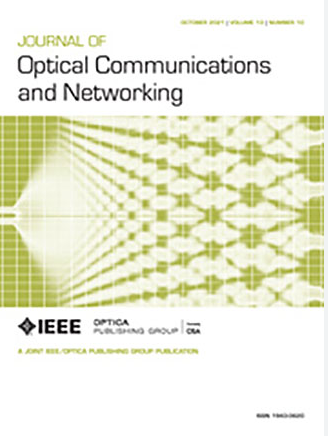Power-over-fiber-based optical wireless communication systems towards 6G
IF 4
2区 计算机科学
Q1 COMPUTER SCIENCE, HARDWARE & ARCHITECTURE
引用次数: 0
Abstract
This paper reports two implementations of power-over-fiber (PoF) solutions applied to radio-over-fiber (RoF) and optical wireless communication (OWC) systems, in the context of an industrial environment. We employ a conventional 62.5-µm multimode fiber (MMF) to deliver optical power to different communication links based on RoF, free-space optics (FSO), and visible light communication (VLC) technologies aiming beyond 5G (B5G) and 6G applications. First, a 3.5-GHz 5G New Radio (5G NR) signal is transmitted throughout a 20-km single-mode optical fiber (SMF) link using RoF technology. Regarding the PoF system, a 5-W optical power is transmitted through a 100-m MMF link. A photovoltaic power converter (PPC) and a DC/DC converter are employed to convert the power from the optical to the electrical domain and adjust the voltage level, respectively, with the purpose of energizing a remote RoF module. The attainable optical and electrical power transmission efficiencies (OPTE and PTE) are 80% and 19%, respectively. Posterior, a second PoF system is implemented to power a hybrid RoF/FSO/VLC B5G system, comprising a 200-m MMF and an additional DC/DC converter. Over 10.5 W of optical power is transmitted to feed an electrical amplifier (EA) and a white LED from the VLC link. In this configuration, we achieve 78% and 18.5% of OPTE and PTE, respectively. Furthermore, a performance investigation based on the root mean square error vector magnitude (基于光纤功率的光无线通信系统迈向 6G
本文报告了在工业环境中应用于光纤无线电(RoF)和光无线通信(OWC)系统的两种光纤供电(PoF)解决方案的实施情况。我们采用传统的 62.5 微米多模光纤 (MMF),向基于 RoF、自由空间光学 (FSO) 和可见光通信 (VLC) 技术的不同通信链路提供光功率,目标是超越 5G (B5G) 和 6G 应用。首先,利用 RoF 技术在 20 千米长的单模光纤(SMF)链路上传输 3.5 千兆赫的 5G 新无线电(5G NR)信号。至于 PoF 系统,则是通过 100 米长的 MMF 链路传输 5 瓦的光功率。光电功率转换器(PPC)和直流/直流转换器分别用于将光功率转换为电功率,并调节电压水平,以便为远程 RoF 模块供电。可实现的光功率传输效率(OPTE)和电功率传输效率(PTE)分别为 80% 和 19%。之后,实施了第二个 PoF 系统,为混合 RoF/FSO/VLC B5G 系统供电,该系统包括一个 200 米长的 MMF 和一个额外的 DC/DC 转换器。传输超过 10.5 W 的光功率,为来自 VLC 链路的电放大器 (EA) 和白光 LED 供电。在这种配置下,我们分别实现了 78% 和 18.5% 的 OPTE 和 PTE。此外,我们还基于均方根误差矢量幅度(${{\rm EVM}_{\rm RMS}}$)指标进行了性能调查,以评估使用所实现的 PoF 系统和传统电力供应的信号。与传统供电的 RoF 系统相比,在第一个实施方案中,100-MHz 带宽的吞吐量达到了 600 Mbps,且性能没有下降;而在第二个实施方案中,同时采用 FSO 和 VLC 技术时,吞吐量达到了 60-Mbps,证明了 PoF 技术在 B5G 和 6G 工业通信中的适用性和潜力。
本文章由计算机程序翻译,如有差异,请以英文原文为准。
求助全文
约1分钟内获得全文
求助全文
来源期刊
CiteScore
9.40
自引率
16.00%
发文量
104
审稿时长
4 months
期刊介绍:
The scope of the Journal includes advances in the state-of-the-art of optical networking science, technology, and engineering. Both theoretical contributions (including new techniques, concepts, analyses, and economic studies) and practical contributions (including optical networking experiments, prototypes, and new applications) are encouraged. Subareas of interest include the architecture and design of optical networks, optical network survivability and security, software-defined optical networking, elastic optical networks, data and control plane advances, network management related innovation, and optical access networks. Enabling technologies and their applications are suitable topics only if the results are shown to directly impact optical networking beyond simple point-to-point networks.

 求助内容:
求助内容: 应助结果提醒方式:
应助结果提醒方式:


